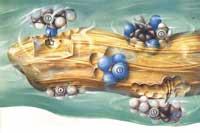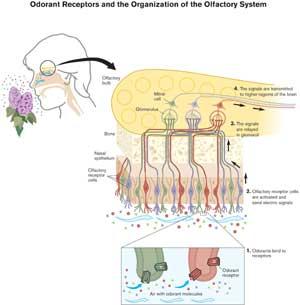What sensations!
2004/01/01 Agirre Ruiz de Arkaute, Aitziber - Elhuyar Zientzia Iturria: Elhuyar aldizkaria
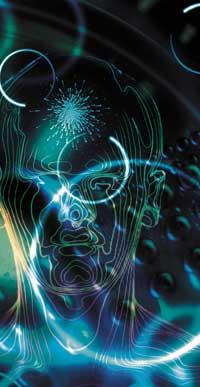
Today the toad is hunger. For several days he has not eaten anything. He has not found food and if he continues, he soon begins to get sick. If a dead fly hung from a thread, standing, without movement, the toad would not see it. And the retina of toads only sees movement. Although he is about to die of hunger, he could not see there, at the height of his eyes, the sweet food that has remained motionless.
However, the human retina and other primates cannot detect movement. It only sees still images, so the brain must do the rest. Specialized connections between neurons allow us to detect movement: we see one image behind the other, very quickly.
But this is not the only difference between us. Humans cannot see the light or color of any wavelength. Many insects also see ultraviolets, and chestnut snakes, such as infrared. But we can only see the colors between red and blue; the rest of the colors are invisible to us.
It is clear that to a large extent every animal species has had its own sensory development. That is the great variety that has produced in nature. The nervous system of each species only reacts to certain vibrations, colors or characteristics, not to any sign. And this, undoubtedly, has limited the evolution of the species.
Each sense a language
In fact, the brain is the one that interprets all the images, sounds, flavors, textures and smells we receive from the medium. In the end they all reach the brain. But in the origin, each stimulus has a totally different character: chemical, mechanical, electromagnetic… In this way, it is not perceived in the same way a sound or a color, and the body has had to design a specific structure to detect each type of stimulus. Sensory cells with very special features and shapes in the eyes, nose, skin, tongue, and other organs of the senses.
In the ear, for example, there is a complex bone system that amplifies the vibrations of sounds. Thanks to this, sensory cells located in the most hidden part of the ear highlight sound and movement — mechanical stimuli — although these stimuli are very small. For this purpose, the cells possess special pilose structures at their end. They are cilia. And the mechanical vibrations of sound waves move and shake them. This peculiar cilia dance informs the brain of the characteristics of the sound heard: frequency, intensity, duration… All the information with a single dance.
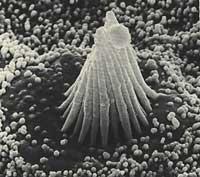
The way to detect odors is completely different, it is not possible to detect them through cilia. Nasal sensory cells have a specific receptor or receptor to know each odorous molecule in the outer membrane. There are thousands of odorous molecules and as many receptors as these. Associated with the molecule, the receptor will identify the smell.
This has surprised scientists a lot. How can a single cell produce so many different receptors? Most receptors appear to have the same basic three-dimensional structure, that is, they have a composition similar to that of the amino acids. But a few amino acids are different. They are key amino acids, which really know the smell. The receptors seem to have a sufficient variability to know thousands of odors.
However, it seems that the very vibration of the molecules also influences. This is testified by the innovative theory published in 1996 by researcher Luca Turin. According to this theory, the receptor, instead of detecting the shape of the molecule, would somehow detect the vibration of it, which would explain the nature of the smell. The theory is totally innovative in biology.
On the other hand, the view works very differently. In fact, specialized eye cells perceive a very different energy: light waves. The medium, as reflected by the light, continuously emits information about itself through waves of light. To detect this energy, the retina of the eyes has special light-sensitive cells. Conical cells, for example, distinguish colors.
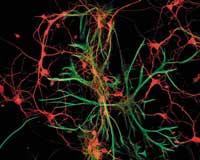
However, unlike the ear, there are many fewer light receptors. Instead of having a specialized protein to absorb the light of each color, humans only have three proteins, each of them absorbs in a certain wavelength. One in the zone of red light, another in the one of green and another in the one of blue. That is why we perceive the colors of the combination of these three basic colors.
In general, if we look at the basic mechanisms of the structures that receive information from the environment, something they have in common is that the stimuli are received in all cases through the plasma membrane of the cell. Cilia, odour receptors, and color receptors, all of them are embedded in the membrane. In fact, the membrane is the only cell structure that has a direct communication with the outside of the cell, so it has had to develop specific structures to detect external stimuli.
Signal conversion
Although the types of stimuli are diverse, the brain knows only one language: the electric one. Therefore, sensory cells have two main functions: to detect the environmental stimulus and to perform the conversion of the signal, that is, to translate it into the language that the brain understands. To do this, it is necessary to transform chemical, electromagnetic and mechanical energy into electrical energy. And that electrical impulse is transported with neuron to the brain through the enormous neuronal network of the body.
The conversion of the signal is also produced in the plasma membrane of the cells and is similar for all sensory neurons. For example, when the silos of the ear receive sound, the input of several ions is activated outside the cell. These ions are usually tiny charged molecules that are introduced into the cell through special channels. The introduction of ions into the cell is an effective way to transform mechanical energy into electrical energy.
In fact, the flow of the ions will inform of the frequency, intensity and duration of the sound in the form of an electrical signal. Thus, the brain can process the signals and know if the stimulus it has received is the human voice, a nice song of birds, or a drop of water falling on the ground.
The same happens with other senses. Immediately after detecting flavors, images, etc., the ions enter all sensory cells. The introduction of these charged molecules alters the natural load potential of the membrane and, therefore, the cell is depolarized by modifying the normal membrane load. From one end of the neuron to the other, the membrane is depolarized, extending it as a depolarizing wave. As a domino effect. Thus, the body will transport information to the brain in the form of a nervous impulse. Neuron with neuron to the body control center.
Sensory organs do not feel it

After all, the brain is the one who listens, ole, plays, sees or relishes; the organs of the senses are only the translators of the information. The clearest example of this is hallucinations. They occur without any external stimulus: the brain, without being up to the eyes, sees certain images, there is no sound and the brain can hear incredible cries.
Hallucinations produce various drugs. Not because they are foreign substances to the body, but vice versa, because they have a great similarity with several molecules of the body. Neurotransmitters. Drugs act as neurotransmitters in synapses between neurons that connect sensory organs and the brain. Through neurons comes to the brain a false electrical message. In this way, the brain detects sensations that are not around it and transforms reality.
But sometimes, in addition to drugs, the neurotransmitters of the human being deceive us. There is no more to see the example of people who lose a member in an accident. They can feel and move the lost body part. The intrigues of the brain.
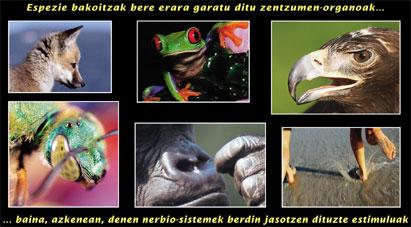
Insects have a very good color vision; colors play a fundamental role in the life of these animals. Bees, for example, when looking for pollen, prefer blue and yellowish flowers. But those who see blue or yellow are other colors for bees. Bees cannot see red, they are not within the spectrum that these insects can see.

As humans have a special sensitivity to red, yellow, and blue, bees have respect to yellow, blue, and ultraviolet. As we form the images with three basic colors, but three other basic ones. Consequently, we perceive very different worlds; as the ultraviolet colors clearly see, in the flowers of the bees appear combinations of completely different colors.

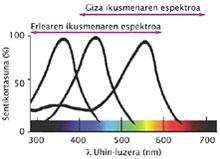

At lunch time we started to enjoy the sweets. Each has a meal he likes the most: oranges, chocolate or croquettes. But what do these foods that we like sweet, taste or smell? It is often difficult to distinguish between the two senses.
And it is that many times what we call flavor is no more than the smell that produces food. Our taste cells only distinguish four flavors: salty, bitter, sweet and acid. The rest of flavors are just perfumes, which come through the nostrils to the sensory cells of smell.
If not, there's no more to see: when we catch the waterfall and eat with our nose closed, the food barely tastes! The croquette we have eaten will be salty or sweet, but it will not taste like croquette. The reason is clear: 80% of the taste of croquette is just smell!
Smell helps animals identify food, companions, and predators. It is the oldest sense from the evolutionary point of view, but it is still about to elucidate what is the molecular basis of smell. The most accepted theory is based on what Linus Pauling explained in 1946, that the size and shape of the odorous molecules are what the nasal receptors know.

In recent years, however, a new theory is emerging. At the moment it is not fully approved, but it is giving much to speak. The main driving force behind this new theory is the Italian Luca Turin. In his opinion, it is not the shape of the molecules that gives character to the smell, at least not just that. “What gives the smell character is the vibrational spectrum of the molecule, which is known by the nasal receptors.”
According to Turin, receptors work as true biological spectrophotometers. In addition, just as eye receptors only know certain colors, nasal receptors would also know certain basic vibrations, not any kind. And the combination of this type of basic vibrations would give different odors.
All molecules vibrate. The vibrations are limited by interatomic linkages, so each molecule has vibrations of a certain energy. When the odorous molecule enters the receptor, the tunnel effect consists of the transfer of electrons from the olorous molecule to the receptor. Thus, the receptor highlights the vibrations of the molecule.
If Luca Turin's theory is accepted, the explanation given to the functioning of the smell would change radically. Some believe it is a sufficient discovery to receive the Nobel Prize, since so far a receptor capable of detecting the vibrations of molecules in living beings is not known. Time will tell.

Gai honi buruzko eduki gehiago
Elhuyarrek garatutako teknologia




